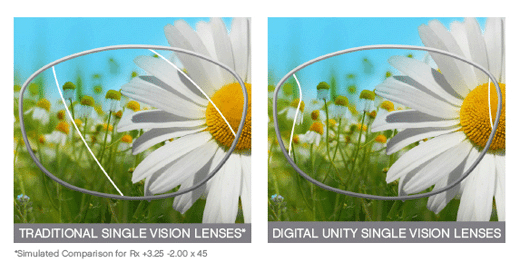
The Verdict On High-Definition Eyeglass Lenses
This post is brought to you by our sponsor, VSP Vision Care and UNITY Lenses
When we last left off, I had just been fitted for my first pair of UNITY Digital Lenses. I had been assured throughout the process that this was going to be the best pair of glasses I’d ever had, but I was skeptical. How much of a difference could these lenses really make?
I received the call that my glasses were ready and dropped everything to go pick them up. (Hey, I said I was skeptical, but I was also intrigued.) Remember, thanks to my VSP Vision Care membership, these state-of-the-art lenses were free to me under my coverage and could be to you as well depending on the frames and specific lenses you choose. I definitely went into this with the mindset that all of these promises were too good to be true. Given that I had ordered sunglasses, and (obviously) tried them on inside the optical place, the first thing I noticed wasn’t how I saw with them (because it was mostly just dark inside), but that—despite having chosen a fairly large frame—my new specs weren’t any heavier than they’d been when I’d tried on the frame with the clear plastic lenses in them. I have a pretty strong prescription and am used to my lenses being substantial; these were noticeably lighter than my non-UNITY lenses.
Once I went outside into the sunlight and could see a little better, that’s when the biggest difference became apparent.

The image above is intended to demonstrate the field of vision differences between regular and UNITY lenses; the idea is that there is necessarily some distortion outside of the center of the lens with traditional lenses, but thanks to the specific digital mapping UNITY utilizes to match both the wearer’s prescription and the size/shape of the frames, that distortion is all but eliminated. In reality, I doubt that most of us glasses-wearers consciously process that loss of clarity on the edges until we’re presented with an alternative.
So here’s the best way I can explain it, having now worn my new specs for several weeks: Putting on my new UNITY Digital Lenses was like going from glasses to contacts. I always figured my vision was as good as it could be, corrected with glasses, until the first time I wore contact lenses. Contact lenses make my vision sharper than glasses with traditional lenses, and I never really thought about why, but I suppose it’s due to the elimination of that whole distortion issue because the corrective lens is directly on your pupil and you’re always seeing right through the center of it. I love the way I see with contacts, but I have sensitive eyes and have never had success with wearing them regularly. (I wear dailies every now and then for just a few hours at a time.) With my new glasses, my vision was perfect. Everything was sharp and clear and made me wonder how I ever thought my old sunglasses were sufficient.
The thing I do most often in my sunglasses is drive, and I spent the first week having a series of veritable aha! moments in the car where I found myself reading signs much further away than I’d previously been able to and realizing just how much I’d been missing, before. That whole thing about how it’s like switching from analog to HD? Totally true. It’s just that you didn’t know what you were missing with analog until you saw your first HD set, and I had no idea how much better I could see with a pair of glasses until I experienced it, myself.
If you want to learn more and stay abreast of UNITY Digital Lenses news/developments, follow the VSP blog and visit UNITY on Facebook. I obviously can’t tell you what to do, but I can tell you that I would have a really hard time going back to “regular” lenses now that I’ve experienced the alternative.
************
Thank you to our sponsor VSP Vision Care. Our sponsors help make this site possible.

